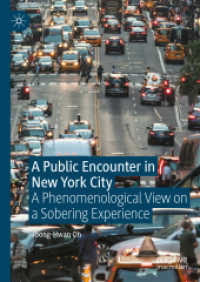Full Description
Environmental risk factors - noise, air pollution, chemical agents, and ultraviolet radiation - impact human health by contributing to the onset and progression of noncommunicable diseases. Accordingly, there is need for preclinical and clinical studies and comprehensive summary of major findings. This book is a state-of-the-art summary of these myriad severe life stressors. The chapters on the different pollutants focus on disease mechanisms (cardiovascular, neurological and metabolic disorders) and on oxidative stress and inflammation. The editors emphasize emerging mechanisms based on dysregulation of the circadian clock, the microbiome, epigenetic pathways, and cognitive function by environmental stressors, and introduce the exposome concept while highlighting existing research gaps.
Key Features:
Links various environmental stressors to the incidence of noncommunicable diseases
Includes chapters on airborne toxins, chemical pollutants, noise, and ultraviolet radiation stressors
Contributions from an international team of leading researchers
Summarizes the impacts of stressors on disease mechanisms
Contents
ch. 1 Man-made environment or living in the Anthropocene - a major health risk factor in the 21st century ch. 2 The exposome concept - description of life-long environmental exposure effects on metabolism, health and disease ch. 3 Problems related to the use of biomarkers of oxidative stress in disease ch. 4 Formation, interconversion, and buffering of reactive oxygen species from gaseous and particulate air pollutants in epithelial lining fluid ch. 5 Chemical modification of proteins by reactive oxygen and nitrogen species under atmospheric and physiological conditions ch. 6 Air pollution and neuropsychiatric disease ch. 7 Underlying mechanisms of the effects of particulate matter in primary and distant organs ch. 8 The ocular surface as a target of air pollution ch. 9 Environmental heavy metals, oxidative stress and disease potential - NRF2 centered genetic and epigenetic mechanisms ch. 10 Insights into the non-coding-RNA regulation of environmental stress-induced disease ch. 11 Oxidative and inflammatory potential of nano/microplastics in living organisms ch. 12 Micro- and nanoplastics contamination: an emerging environmental issue for skin health ch. 13 Waterpipe smoking and e-cigarettes: a safer alternative to combustible cigarettes? ch. 14 The aryl hydrocarbon receptor as an environmental sensor and mediator of stress and inflammation ch. 15 Oxidative stress and inflammation contribute to traffic noise-induced vascular and cerebral dysfunction via uncoupling of nitric oxide synthases ch. 16 Noise pollution and neuropsychiatric disease ch. 17 Imaging of metabolic activity adaptations to UV stress and differentiation at cellular resolution in skin and skin equivalents - Implications for oxidative UV damage ch. 18 Adverse health effects of UVR on skin and other organs ch. 19 Electromagnetic fields redox signaling modulation in brain ch. 20 How adverse childhood experiences increase inflammation and oxidative stress ch. 21 The role of oxidative stress in cardiovascular disease caused by social isolation and loneliness






